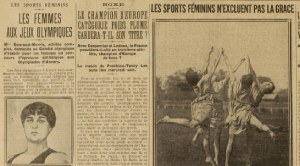
 The case of Caster Semenya politicises through sport the intersex condition.
The case of Caster Semenya politicises through sport the intersex condition.
Ever since the late 2000s, the South African athlete Caster Semenya has been in the crosshairs of the media and major sports institutions. However, the “Semenya case” largely outstrips the realm of sport, raising as it does both healthcare and socio-political stakes and pertaining more broadly to the problematics of gender.
Caster Semenya became a household name during the Berlin World Championship when she won the 800 metres race on 19 August 2009. Her physical appearance, deemed “too masculine”, raised questions, notably within the refereeing body of the International Association of Athletics Federations (IAAF). She was subjected to a sex verification test, involving gynaecological, hormonal and chromosomal checks before her title could be validated, and banned from competitions pending the results. The verdict fell in July 2010 allowing Semenya to keep her gold medal and to compete as a woman. This did nothing to lessen the Semenya controversy, however, which got rekindled at every fresh victory. In order to settle once and for all the issue of female athletes with what got termed disorders of sexual development, the so-called hyper-androgynous sportswomen – such as Semenya, the IAAF and the International Olympic Committee (IOC) fixed in 2011 a top testosterone level that would precisely differentiate men from women: a testosterone level under 10 nmol/Litre of blood. The eligibility criterion was finally brought to <5.0 nmol/L in 2018, which excludes a number of female athletes among whom Semenya. The only solution to continue to compete as a woman is then to submit to a hormonal treatment which brings down the testosterone level. When called upon, the Court of Arbitration for Sport acknowledged in its 1 May 2019 judgment the discriminatory nature of the regulation but validated it as a proportionate, reasonable and necessary way to preserve the integrity of female athletics according to the principle of equal opportunities.
In no time at all, the Semenya case was taking a political turn – not least as a result of her newsworthiness worldwide. As early as 2009, the Republic of South Africa appraised the United Nations Organisation of what it considered the humiliating treatment the IAAF had inflicted on their athlete. There ensued a growing mobilisation around Semenya. Stigmatised, cast out to the realm of the abnormal, and pathological, she took on the mantle of a martyr at the hands of societies intolerant of sexual diversity. Her case exposed and epitomised the discriminations daily suffered by intersex and more broadly LGBTQ individuals, notably in legal and medical terms. In February 2010, the Organisation Intersex International (OII) launched a petition aimed at putting an end to the OIC’s “discriminatory pathologizing” of intersex athletes for the purported sake of sportspeople’s healthcare. In 2018, some sixty world-famous sportswomen, among whom tennis champion Billie Jean King, sprinter Dutee Chand as well as footballer Megan Rapinoe, signed an open letter asking the IAAF to end its discriminatory policy, a policy that can be traced back to the gender verification female athletes have had to undergo since the mid-20th century. In March 2019, the United Nations Human Rights Council cautioned against the new rules set by the IAAF and sided with Semenya – to no avail.
Thus, the “intersex quandary” in sport turns out to bring into light moral judgments founded in a binary frame of reference, out of sync with the biology, but which have no less long presided over the health policies affecting LGBTQ people. It brings out their efforts to break with case management long confined to the medical, nay the psychiatric realms, to embrace social and cultural approaches. More specifically, it expresses their determination to move from the position of patients in need of care ascribed to them to that of individuals suffering exclusion and discrimination and whose rights and citizenship are to be fully recognised.
The sporting field, a bastion of virility has thus become, through its exemplarity, performativity and henceforward close links with medicine, the chosen arena to observe the confrontations around gender norms and sex-related rights and, beyond, individual rights.
Références :
Anaïs Bohuon, Le Test de féminité dans les compétitions sportives. Une histoire classée X ? Paris, éditions iXe, 2012.
Sandy Montañola & Aurélie Olivesi: Gender Testing in Sport, Ethics, Cases and Controversies, London, Routledge, 2016.
To quote this paper : Sylvain Villaret, "Caster Semenya" in Hervé Guillemain (ed.), DicoPolHiS, Le Mans Université, 2021.